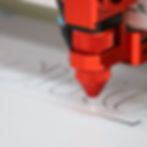
THE LASER PROCESS
Precision Laser Technology Bringing Your Ideas to Life
Laser cutting, engraving, and marking rely on advanced laser technology to deliver exceptional precision and quality. The process begins with a powerful laser beam emitted from a specialised laser tube, which is then carefully directed and focused onto the material surface. This highly focused beam enables us to cut through, engrave, or mark a wide range of materials with intricate details, all while maintaining high speed and accuracy.
What sets laser processes apart is their ability to achieve fine, clean results without the wear and tear associated with traditional cutting or engraving tools.
Whether it's melting, vaporising, or etching, the laser beam’s energy interacts with the material to create precise designs with minimal waste. The versatility and efficiency of laser technology make it ideal for both simple and complex projects.
Below, we dive into the mechanics of how the laser works, explaining the step-by-step process involved in cutting and engraving, and the differences between raster and vector engraving techniques. Understanding these processes will help you appreciate the capabilities and benefits of laser technology in various applications.



How the CO2 Laser Works
The CO2 laser is a powerful tool used for cutting, engraving, and marking a variety of materials. It works by using a special type of gas called carbon dioxide (CO2) to generate a highly focused laser beam.
This beam is incredibly precise, making it perfect for creating detailed designs on materials like wood, acrylic, leather, and even certain metals.
The CO2 laser process provides clean, accurate results and is ideal for both simple and detailed designs.
Whether you're creating custom signs, personalised gifts, or intricate patterns, our CO2 laser ensures you get the best results every time.
The process begins when the CO2 gas inside the laser machine is energised to create a strong, invisible laser beam. This beam is then directed through mirrors and lenses, which help guide and focus it onto the material.
The laser beam is concentrated into a small, precise spot, allowing it to interact with the material’s surface. This intense focus is what makes the laser so accurate; whether it's cutting through the material or engraving a design on it.
When the laser hits the material, it either burns, melts, or vaporises the surface, depending on what’s being done. For example, it can cut clean lines, etch detailed images, or mark the surface with text or logos; all with high precision.
The laser head moves across the material following the design, ensuring that the finished result is exactly as intended. This movement is controlled by advanced technology, which makes it easy to create intricate and consistent patterns or shapes.
CO2 lasers are designed to run efficiently and safely. To keep the machine running smoothly, it uses a cooling system to prevent overheating, ensuring consistent results every time.

Laser cutting is a method of cutting out detailed designs quickly, precisely, and effortlessly from a variety of materials, using design software to guide it.
The laser beam is fired within the machine, which hits the surface of the material and heats it so strongly that it melts or completely vaporises. The cutting process begins once the laser beam has completely pierced the material and follows a geometry path that separates the material, causing the 'cut'.
One of the main advantages of laser cutting is the accuracy of detailed cutting, which scissors or knives simply cannot achieve. The speed of laser cutting is also a great benefit, especially when large quantities are to be achieved.
Unfortunately, our laser machine cannot cut metals or hard materials such as glass, but they can be laser engraved/marked with amazing results.

Common Questions:
A wide range of materials, from woods to acrylics, foam to food, stone to glass.
Lasers offer exceptional precision, capable of creating detailed designs and clean cuts with minimal waste.
Getting started is easy! Contact us with the details of your project and we'll guide you through the process.
Check out our full range of FAQs HERE.




